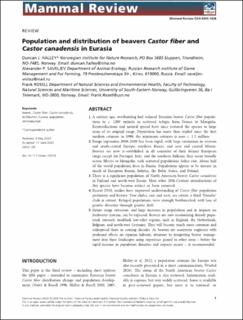| dc.description.abstract | 1. A century ago, overhunting had reduced Eurasian beaver Castor fiber populations to c. 1200 animals in scattered refugia from France to Mongolia. Reintroductions and natural spread have since restored the species to large areas of its original range. Population has more than tripled since the first modern estimate in 1998; the minimum estimate is now c. 1.5 million.
2. Range expansion 2000–2020 has been rapid, with large extensions in western and south-central Europe, southern Russia, and west and central Siberia. Beavers are now re-established in all countries of their former European range except for Portugal, Italy, and the southern Balkans; they occur broadly across Siberia to Mongolia, with scattered populations father east. About half of the world population lives in Russia. Populations appear to be mature in much of European Russia, Belarus, the Baltic States, and Poland.
3. There is a significant population of North American beaver Castor canadensis in Finland and north-west Russia. Most other 20th-Century introductions of this species have become extinct or been removed.
4. Recent DNA studies have improved understanding of Castor fiber population prehistory and history. Two clades, east and west, are extant; a third ‘Danube’ clade is extinct. Refugial populations were strongly bottlenecked, with loss of genetic diversity through genetic drift.
5. Future range extension, and large increases in populations and in impacts on freshwater systems, can be expected. Beavers are now recolonising densely populated, intensely modified, low-relief regions, such as England, the Netherlands, Belgium, and north-west Germany. They will become much more common and widespread there in coming decades. As beavers are ecosystem engineers with profound effects on riparian habitats, attention to integrating beaver management into these landscapes using experience gained in other areas – before the rapid increase in population densities and impacts occurs – is recommended. beaver, Castor fiber, Castor canadensis, distribution, Eurasia, population, reintroduction | en_US |

